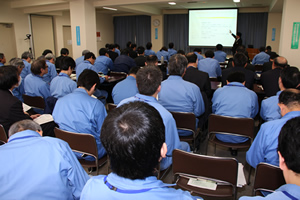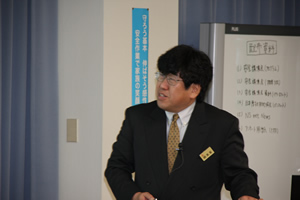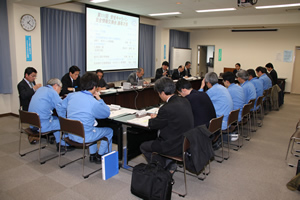|
|
 |
|
The 111th Safety Caravan was held at the Mitsubishi Electric Corporation’s Transmission & Distribution Systems Center in Tsukaguchi-honcho, Amagasaki-shi, Hyogo Prefecture on February 27, 2009. |
| Safety Presentation |

|
|
During the Safety Presentation
|
The session was attended by 82 employees from Mitsubishi Electric Corporation’s Transmission & Distribution Systems Works and other nearby Mitsubishi Electric Corporation offices.
Mr. Yoshiaki Nakatani, Director of the Mitsubishi Electric Corporation’s Transmission & Distribution Systems Works, gave the opening address prior to the main presentation.
This Transmission & Distribution Systems Center has now spread its operational hubs across four different districts – the Itami district, the Ako district, the Seishin district of Kobe City and the Kobe district – in order to provide “one-stop” power transmission and distribution service. With regard to the field of nuclear power, we manufacture such products as switchgear in Itami, transformers in Ako, and protection relays in Seishin. In addition, we are involved in the maintenance and servicing of existing nuclear plants.
The principle we strive to uphold daily is “safety before all else”. Specifically, this entails identifying the seeds of potential disaster before they have a chance to germinate, such as through the systematic risk assessments begun last year. Also, we take into consideration the human factor, which dictates the need of ensuring personal safety, by having all levels of management, from directors to general managers to section chiefs to subsection chiefs, perform regular onsite reviews and inspections. Through these sorts of initiatives, we are able to not only identify the seeds of potential disaster but also to provide education, instruction and a sustained awareness onsite.
Today, Professor Fudano will speak to us on the topic of “Engineering Ethics”. This is a topic of growing importance for a manufacturer such as ourselves, whose operations stem from our technical expertise. Also, by creating a common venue for nuclear energy specialists, I believe that this affords the perfect opportunity for staff members to step back from the duties that they immerse themselves in daily and refresh.
It is my hope that the cases we look at and discuss today will serve to fortify our thinking and initiatives with regard to safety, quality and ethics.
Following the opening address, Professor Jun Fudano, Director of the Applied Ethics Center for Engineering and Science at Kanazawa Institute of Technology, gave a presentation entitled “Positive Ethics for Engineers – Self-actualization, Safety, Security and Values –.”
The main points of Professor Fudano’s beneficial presentation are as follows: |

|
|
Professor Jun Fudano,Director
of the Applied Ethics Center for Engineering
and Science at Kanazawa Institute of Technology
|
While the word “ethics” often conveys a somber image, it should not be viewed as an enumeration of rules which must be obeyed; rather it is about asking what actions and behavior are good or bad.
In America, rigorous training standards for engineers are established primarily by ABET (The Accreditation Board for Engineering and Technology); in Japan, the ABET equivalent known as JAFEE demands that students be imparted with a sense of personal responsibility towards society (engineering ethics) by enabling them to think critically about such questions as “what constitutes human happiness and wellbeing”.
My definition of engineering ethics would be “an overall normative system – and an ongoing, critical discussion of that system – rendering value judgments on the rightness or appropriateness of actions which seek to put to use the engineer’s mathematical and scientific knowledge, acquired through study, practice or professional experience, towards the economical use of natural energy for the benefit of humanity. This includes, furthermore, the capability to render such judgments based on the normative system.” While this definition may seem loose and disorganized, engineering ethics is not something learned from a lecture, and this definition emphasizes the fact that it comes from practical wisdom.
Today, engineers are faced with ethical dilemmas in any number of areas. And in order to enable them to tackle their jobs with enthusiasm and avoid succumbing to these dilemmas, corporate and organizational values that demonstrate integrity with regard to the basic engineering values of “public safety, health and wellbeing” need to be established together with a program for sharing those values, i.e., an “ethics program of shared values”. For this ethics program of shared values to work, six elements are needed: a code of ethics; commitment and leadership by the top executives and management; clear personal and departmental responsibilities; promotion of ethics-related communication; ethics training and development; and the establishment of a helpline.
With technology continuing to develop at a rapid pace, it is up to engineers to make judgments about what is important and what is not. Thus, we must foster environments that do not force engineers into ethical dilemmas when faced with such decisions. By ensuring that the ethical program of the organization is one that places an emphasis on engineers, we can enable engineering-related businesses to fulfill their social obligations while playing an indispensible role in society. I want us to aim not for rule-bound, “stultifying engineering ethics” but, rather, for shared values that promote “positive ethics for engineers”.
Some comments from the audience survey taken after the presentation:
-
This lecture was easily grasped and left a positive impression of ethics. I came away thinking that ethics training could be carried out without the need for heavy-handedness. I learned in no small part that K/H helps motivate engineers and produces positive results.
-
I was fascinated by the discussion of how technological development gives rise to new ethics. The latter half of the talk was also of great interest, and at the end I found myself wishing it had gone on for another 30 minutes or more.
-
What is an engineer? This talk was a good opportunity for me to think deeply about my company’s corporate statement: “CHANGE FOR THE BETTER”.
-
With regard to the subject of an ethics program, I feel that it is important to work continually to find an ideal mix of “compliance” and “shared values” approaches.
-
The topic of engineering ethics was one I had not seriously thought about before and, thus, felt it to be both surprising and fresh.
-
Amidst my daily rush of work duties and an overload of information, I found this lecture to be of great use and an opportunity to reflect on the subject of ethics – not only as an individual but also as a member of a corporate structure.
|
Safety information exchange session |

|
|
During the Safety information exchange session
|
At the safety information exchange session, six items (“noticed items”, “items of concern”, “problem items”, etc.) which Mitsubishi Electric has utilized as part of its engineering ethics-related safety culture activities in the past were used as subject matter in an afternoon group discussion involving Professor Fudano about “what role engineering ethics should play in business and how such ethics they can be put in place”.
|
|
|







